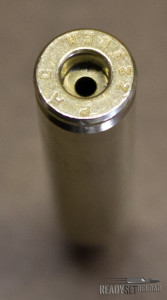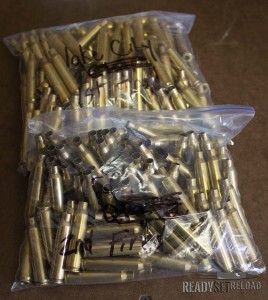Inspecting and Sorting Brass
The inspecting and sorting brass step is really a “housekeeping” or organization step that I like to complete so I can keep things in order. Since I’m reloading for accuracy I like to keep all of my brass sorted by manufacturer.
I can’t remember where I read this but somebody posted a chart that contained several different manufacturers of brass. An analysis was performed on each piece of brass and the results were shown. The analysis consisted of taking each piece of brass, trimming it (we will discuss in the next section) and filling it with water. The water was then measured and the results were shown in the chart. The take away was that the volume of water in each piece of brass varied by manufacturer and sometimes even by different production years of the same manufacturer. So, if you’ve read your Lyman handloading manual you will already know that loading X amount of powder/bullet into a case with two different volumes causes different pressures. Having different pressures will affect velocity which will in turn affect accuracy. This is the reason why sorting brass is important.
I only use brass that I’ve purchased or has been the bi-product of factory ammo which has been fired while I was present. Grabbing random brass isn’t worth it in my opinion. You never know if it has already been reloaded by somebody and if so, how many times its been fired. It’s not worth it in my opinion.
Sometimes I come across manufacturers that I’m not familiar with. I found a pretty good list of manufacturer headstamps at these websites:
I’ve also learned that the two digit number that is sometimes present is the year the brass was manufactured. Below is brass manufactured from a Korean company called Precision-Made Cartridges:

Headstamped PMC or Precision-Made Cartridges
Now that I’ve explained the method to my madness on to the fun stuff, sorting brass into piles. Okay I lied, its not very fun. But, this is a very important part of the process. At this time I inspect each piece of brass for failures; more on this at the end of this post. Once they are in piles I break out Zip-lock bags, throw each pile in them and add a quantity. The reason I add a quantity is because if I have a box of 250 bullets, its easy to pick multiple bags of brass that add up to 250.
Why do I need to add a quantity you ask? Well, as my skills have progressed I learned that by using an overall length (OAL) gauge you can increase your accuracy dramatically. Once you get this measurement you can use it to reload all bullets in the box. The “ogive” (or point where the bullet touches the lands on your barrel) on each bullet in the same box are very close. The “ogive” between two different boxes can be quite a b it different. A good analogy to this is purchasing ceramic tile. You want to buy tile from the same lot so the patterns are similar. Same thing here, all of the bullets in each box (or lot) are produced at the same time and are very similar. I will be posting a section that talks about how to use an OAL gauge and this topic more in the future. You don’t need to worry about this right now, its more of an advanced topic and not a requirement at this time. With this being said, I still think its a good idea to add quantities to each bag.
Another important thing to write on the Zip-lock bag is how many times the brass has been fired. Each time you fire a round the brass will expand to the inside of your gun’s chamber. When this happens (especially on a

Labeled ZipLock Bags
necked cartridge) the brass will get longer causing the walls of the brass to become thinner. Over time, the brass will become so thin that it will crack. As you can probably guess, if you fire a reloaded round with a cracked cartridge gasses will escape in all the wrong places in your chamber likely causing catastrophic failure or even injury, death, all that good stuff. This is why I inspect each piece of brass while I sort them into piles. The brass is clean, primer is out and failed pieces of brass are easy to spot. Finally, if I find that roughly 5% of the pieces in a batch are cracked I throw the whole batch in the garbage. This is why its important to sort brass by batches and how many times its been fired.
On a side note, straight walled brass doesn’t expand as much as necked brass does. Because of this, the brass isn’t put under as much stress allowing you to reload them many more times without failure. Another benefit of straight walled brass is since it doesn’t expand as much its less likely that you will need to trim it; which we will cover in a future section. But first, on to the first topic of part 3 which is removing the military crimp and deburring the flash hole.

